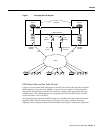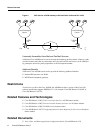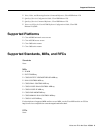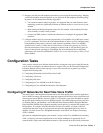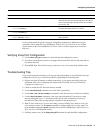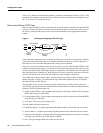
Configuration Tasks
Voice over IP for the Cisco AS5800 7
• Integrate your dial plan and telephony network into your existing IP network topology. Merging
your IP and telephony networks depends on your particular IP and telephony network topology.
In general, we recommend the following suggestions:
— Use canonical numbers wherever possible. It is important that you avoid situations where
numbering systems are significantly different on different routers or access servers in your
network.
— Make routing and dialing transparent to the user. For example, avoid secondary dial tones
from secondary switches, where possible.
— Contact your PBX vendor for instructions about how to reconfigure the appropriate PBX
interfaces.
• Configure another device in your network (preferably a Cisco 2600 or Cisco 3600 series router)
to act as a gatekeeper. The Service Provider implementation of Voice over IP is configured using
both gatekeepers and gateways. Because of the extensive capabilities of the Cisco AS5800
universal access server, it is likely that it will function as a carrier class gateway in a Service
Provider environment. Unless it has a gatekeeper to interact with, it will periodically query all
devices in the network, searching for a gatekeeper. For more information about configuring
gatekeepers, refer to the Cisco IOS Release 12.0(3)T Service Provider Features for Voice over IP
feature module.
Configuration Tasks
After you have analyzed your dial plan and decided how to integrate it into your existing IP network,
you are ready to configure your network devices to support Voice over IP. The actual configuration
procedure depends entirely on the topology of your voice network, but, in general, you need to
complete the following tasks:
• Configuring IP Networks for Real-Time Voice Traffic
• Configuring Voice Ports
• Configuring Dial Peers
• Configuring the Cisco AS5800 as an H.323 Gateway
• Configuring the Cisco AS5800 for Interactive Voice Response
Configuring IP Networks for Real-Time Voice Traffic
You need to have a well-engineered network end-to-end when running delay-sensitive applications
such as VoIP. Fine-tuning your network to adequately support VoIP involves a series of protocols and
features geared toward Quality of Service (QoS). It is beyond the scope of this document to explain
the specific details relating to wide-scale QoS deployment. Cisco IOS software provides many tools
for enabling QoS on your backbone, such as Random Early Detection (RED), Weighted Random
Early Detection (WRED), Fancy Queuing (meaning custom, priority, or weighted fair queuing), and
IP Precedence. To configure your IP network for real-time voice traffic, you need to take into
consideration the entire scope of your network, then select the appropriate QoS tool or tools. In
addition, you must use the Cisco IOS ip cef command to ensure that Cisco Express Forwarding
(CEF) is enabled.
QoS must be configured throughout your network—not just on the Cisco AS5800 devices running
VoIP—to improve voice network performance. Not all QoS techniques are appropriate for all
network routers. Edge routers and backbone routers in your network do not necessarily perform the





